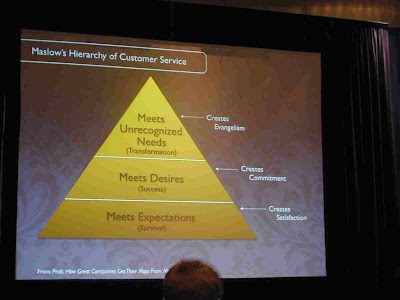
On Wednesday, September 17, I focused on the marketing thread of the Web 2.0 Expo in here New York. The first session I attended was Customer Service is the New Marketing given by Lane Becker. (Again, this is just my subjected summary and should not be taken as a literal or accurate transcription of Lane Becker's words, although the picture above is him.)
He reiterated what's been said many times in reference to Web 2.0: it's all about customer service. And he should know: he's set up the website http://getsatisfaction.com where anyone can talk about any company or any product (their motto: "People-Powered Customer Service For Absolutely Anything!").
He then proceeded to an example: the online shoe store zappos.com. From its outset this store has focused all its efforts on customer service. This is apparent at every level of the organization. At its core, it is focused on customer service. Most companies can't afford to throw everything into customer service. But at Zappos, new employees must have FOUR WEEKS of customer service training, and must spend one week in the "call center" helping customers. It doesn't matter what level of the organization you are: all employees, from bottom to the top, must have at least one week of customer service. This training when you are hired, and for at least one week every year.
Becker then brought up Maslow's Hierarchy of Customer Service:
 The bottom line of this hierarchy is that one creates evangelism through meeting unrecognized needs. In other words, customer service = growth; customer loyalty = profits.
The bottom line of this hierarchy is that one creates evangelism through meeting unrecognized needs. In other words, customer service = growth; customer loyalty = profits.So - what kind of company are you?
- Customer focused (like Zappos, Four Seasons, or Craigslist)?
- Product-focused (e.g. Apple, Google, etc.)?
- Infrastructure-focused (most telecommunications companies)?
- Put conversations at the center of your business
- Reduce your sphere of control to increase sphere of influence
- Smash the silos that exist between your business and the world around it
Rather, friction-free communication is the new norm. There are many venues of communications. It's easy to talk to friends, but it's hard to talk to companies.
Examples of the reversed trend: the company Timbuk2 - a San Francisco-based company that makes bags. They embraced the web and had one person charged with figuring out ways to talk to customers. That's what her job is entirely about. She set out to discover where are customers talking. She found a Flickr group called What's In Your Bag? It was a fad that caught on in Flickr where people emptied out their bags, arranged its contents on a table, photographed it, and uploaded it to Flickr. So the Timbuk2 staff member noticed a large number of bags were from her company! Thus she identified a valuable thing for her company. In fact, they no longer focus on professional photography but use examples from Flickr to show their products.
Becker had a cute story about a potential Timbuk2 customer wanting a diaper bag (appropriate for a nursing mother). They don't make such bags, but based on what other people had done, the customer service rep was able to advise the customer on how to accessorize her bag so that it would function for a a mother nursing a baby.
These stories exemplify reaching out and talking to customers. Understand the language used by the customers - the way they see it - and translate it. This avoids pushing business jargon on them.
No. 2: "Reduce sphere of control." Engage your evangelists. Reduce your sphere of control to increase your sphere of influence. The example of Comcast was cited, particularly the culture around the website and phrase of Comcast Sucks (http://www.comcastsucks.org/). At one time they were avoiding conversations with customers.
Comcast thought: what if we took 5 people and charged them with customer engagement (giving them a name and a Twitter site: Comcast Cares). This is the work of Frank Eliason, to reach out and engage customers. He functions like the concierge. Frank can identify where traditional customer support channels are not working or where they are breaking down.
It's an opportunity to reach into the business and manage the social mood of Comcast. But it also changes ideas about the way Comcast views itself. These conversations have the potential to change the company - don't underestimate the internal impact.
No. 3: "Smash the silos." Example of a silo: the internal company response: "It's not our problem." Becker brought the example of the day on Twitter that Nokia wasn't working. An incompatibility existed between Nokia and T-Mobile, resulting in a lost of connectivity. Nokia didn't diagnose it -- it was the customers who figured out what was wrong. They flooded T-Mobile and forced them to address the problem. On its own, Twitter would not have been able to diagnose and fix the problem as fast.
Take an open approach to customers - there are more of them than you. Let them harness applications to get a sense of what works and what doesn't work.
Customer service in the form of ongoing conversations is the way the world is going. Companies have to get on board. A good example: Apple, and its stores' "Genius Bar."
And always ask yourself: What would a concierge do?
No comments:
Post a Comment